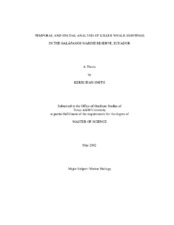| dc.description.abstract | A study was conducted using data compiled from two sources to test the hypothesis that killer whales display seasonal variability in their occurrence in the Galapagos Marine Reserve (GMR), Ecuador. Three questions arise from this hypothesis: 1) do killer whale sightings display temporal variability; 2) are sightings spatially associated with resources; and 3) if sightings are spatially associated with resources, does the spatial association change temporally? I combined and evaluated two sets of GMR killer whale sighting data (n=154) spanning a twenty-year time frame collected via opportunistic sightings by an observer network and shipboard line-transect surveys. I tested for a (a) correlation between the total annual sightings and bi-annual seasonality (upwelling versus non-upwelling); (b) correlation between the total annual sightings and the Multivariate El Nino Southern Oscillation Index (MEI); (c) correlation between sightings, the MEI, and seasonality; (d) spatial association between sightings and resources; and (e) spatial change in sightings with seasonality. Sightings were roughly equally distributed between non-upwelling (56%) and upwelling seasons (July-December). No direct correlation was found between sightings and the MEI. Sightings occurred more often than expected by chance during the peak upwelling months of August-November when the MEI was within one standard deviation of the average (binomial z=2.91, p<0.05). Sightings were spatially associated with areas of high chlorophyll a values (binomial z=4.46, p<0.05), pinniped rookeries (binomial z=6.03, p<0.05), and areas with high combined resource value (binomial z=5.36, p<0.05). The spatial distribution of sightings did not shift with seasonality, with the exception that sightings occurred less often than expected in areas of low combined resource value during the upwelling period (binomial z=-3.17, p<0.05). Though variability in observer effort should be considered when evaluating these data, these results do not suggest a strong pattern of seasonal occupancy or that killer whales are responsive to El Nino Southern Oscillation events. Further research is needed to determine if killer whales in the GMR comprise a single resident population, multiple resident and transient populations, or if killer whales observed in the GMR are part of a population inhabiting the eastern tropical Pacific region, which visit the area at various times. | en |


